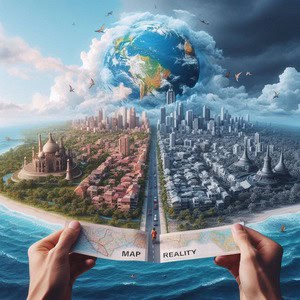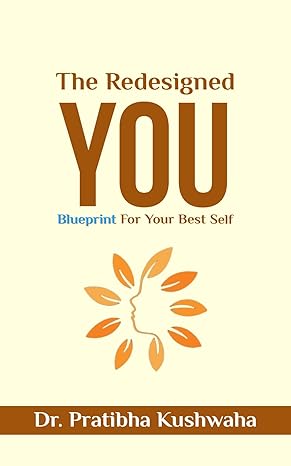Imagine you’re walking down a crowded street, surrounded by people. You might think that everyone around you is sharing the same experience as you, right? But here’s the truth: each person on that street is actually walking through a completely different reality. How is that possible? Because the way we perceive the world isn’t the world itself — it’s just a representation of it.
This concept, known as “the map is not the territory”, highlights the fact that what we believe to be reality is simply our personal experience of it. As human beings, we don’t respond to reality itself, but rather to our interpretation of it, which is shaped by our beliefs, emotions, and past experiences. Let’s dive deeper into how this powerful principle influences the way we navigate life.
What Does “The Map is Not the Territory” Mean?
The phrase “the map is not the territory” was coined by Polish-American philosopher Alfred Korzybski. In essence, it means that our perception of the world, much like a map, is a representation — not a direct reflection — of reality. Just as a map provides a simplified version of a physical location, our minds create mental “maps” to make sense of the world around us. However, just like a map can never capture every detail of a landscape, our mental maps also come with distortions, omissions, and generalizations.
Think about how you use a map. It shows key roads, landmarks, and destinations, but it doesn’t show every building, every person, or every subtle detail. Similarly, our mental maps are full of shortcuts and filters. These mental filters are shaped by our personal experiences, our beliefs, and the emotional state we’re in at any given time.
So, when you think you’re responding to reality, what you’re actually responding to is your version of it — your internal map. And just as no two maps are exactly the same, no two people see the world in exactly the same way.
People Respond to Their Experience, Not Reality
This idea — that people respond not to reality but to their experience of it — is central to understanding human behavior. Every day, our brains are processing vast amounts of information, and it does so by filtering, distorting, and deleting data to make it manageable. This filtering process is influenced by our beliefs, our upbringing, and the emotions we carry from moment to moment.
Let’s take a simple example: Imagine two people walking into a party. One person is exhausted after a long day and just wants to go home. The noise, the crowd, and the energy of the room feel overwhelming and stressful to them. Meanwhile, another person, who is excited to meet new people and socialize, sees the party as lively, fun, and full of opportunities. Same party, two entirely different experiences.
In this situation, neither person is “wrong” — they are simply responding to the same event through the lens of their personal maps. This is why two people can witness the same event but walk away with completely different interpretations. It’s not the reality they’re responding to; it’s their experience of that reality.
Real-Life Implications: Understanding Relationships, Communication, and Conflict
The concept of “the map is not the territory” plays out in every area of life — especially in relationships and communication. Have you ever had an argument with someone where it felt like you were both talking about completely different things, even though the topic was the same? That’s because each person’s internal map was guiding how they interpreted the conversation.
In an argument, one person might feel attacked or criticized, while the other person feels misunderstood and defensive. Neither interpretation is “right” or “wrong”; they’re simply reflections of each person’s internal map. The problem often arises when people assume that their map is the reality — that the way they see the world is the way everyone else should see it too.
Understanding this principle can improve how we communicate with others. When we recognize that everyone has their own unique map of the world, we become more empathetic listeners. Instead of assuming that someone is reacting “wrongly,” we start to see that they are simply navigating life using a different map than ours.
This awareness is especially important in professional settings. In a workplace, a leader who understands that employees have different internal maps can manage their team more effectively. Rather than expecting everyone to be on the same page, the leader acknowledges that each person may interpret the same message differently. This can lead to better communication, collaboration, and ultimately, better results for the entire team.
Can You Change Your Map?
Here’s the good news: while the map isn’t the territory, you can change your map. Neuro-Linguistic Programming (NLP) is based on the idea that our mental maps are not fixed — they can be updated and reshaped to serve us better. By becoming more aware of the beliefs, biases, and emotional patterns that shape our maps, we can begin to see the world in a more empowering way.
Let’s say, for example, that someone has a deeply ingrained belief that “I’m not good enough.” This belief is a part of their map, and it influences how they see themselves and the world around them. Because they believe they’re not good enough, they might hesitate to take risks, avoid challenges, or shy away from new opportunities.
But here’s the thing: that belief isn’t reality. It’s just a story that their mind has created based on past experiences. Through NLP techniques, they can challenge that story, recognize it as just one possible map of the world, and replace it with a more positive and empowering belief. They might start telling themselves, “I am capable of growth and improvement.” This shift in their internal map can open up new possibilities and change the way they experience life.
Similarly, if someone constantly feels overwhelmed by stress, it could be because their internal map is full of filters that highlight danger and negativity. By becoming more aware of these filters, they can begin to reframe their experiences, focus on positive aspects of situations, and feel more in control of their emotions.
Conclusion: Your Map, Your Life
The next time you find yourself feeling stuck, misunderstood, or overwhelmed, take a moment to remember that the map is not the territory. What you’re responding to is not reality itself, but your experience of it — your map. And once you recognize this, you gain the power to change your map and, by extension, change your life.
By challenging old beliefs, reframing negative experiences, and consciously shaping your internal map, you can begin to see the world in new, more empowering ways. This is the essence of personal growth and transformation.
If this concept resonates with you and you want to explore how to reshape your internal map, consider diving deeper into NLP techniques or reaching out for guidance. You have the ability to change how you experience the world — and with it, change the reality you live in.
Remember, your reality is shaped by your mind. Make it work in your favor.
Let this principle guide you as you move forward, and share it with others who may benefit from seeing the world through a new lens. After all, we are all walking through life with our own maps — but with awareness, we can choose how we navigate them.


